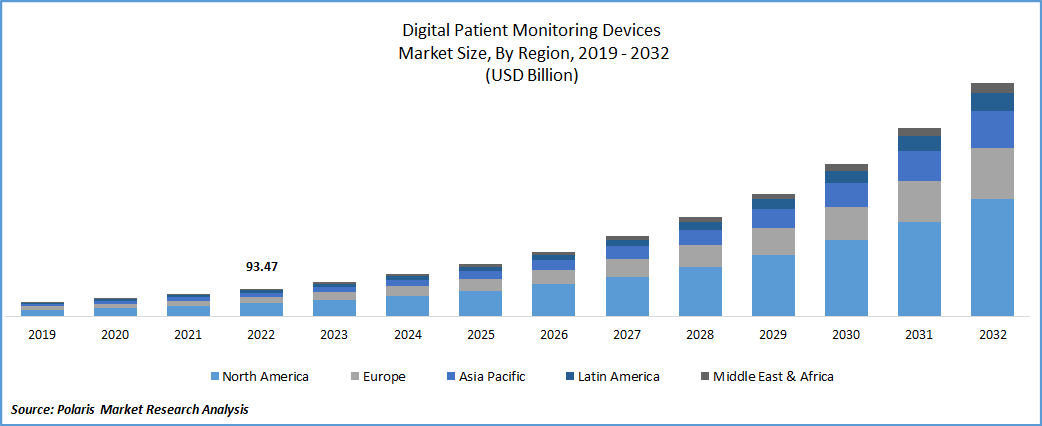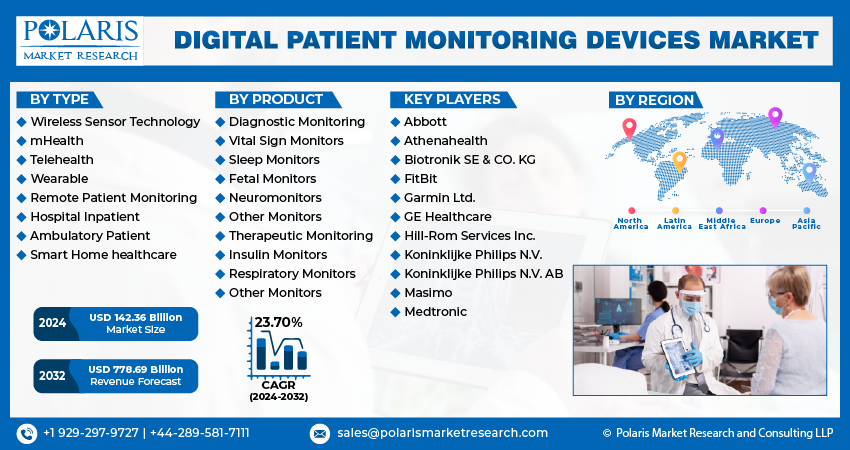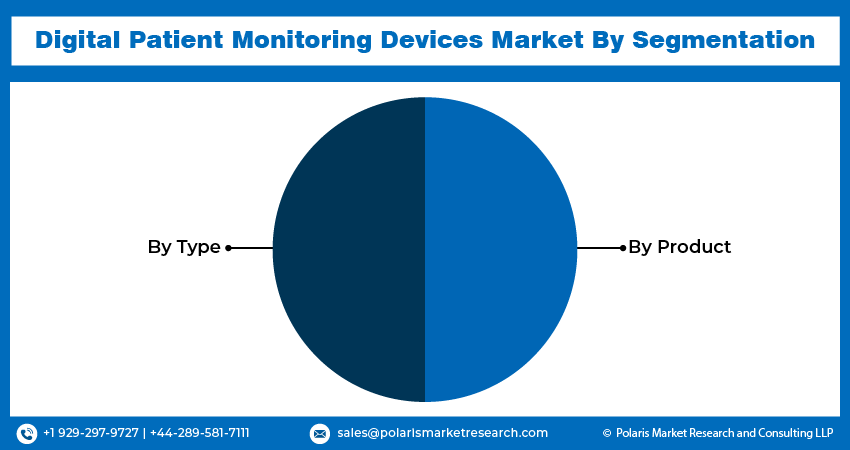
Global Digital Patient Monitoring Devices Market Share, Size, Trends, Industry Analysis Report, By Type (Wireless Sensor Technology, mHealth, Telehealth, Wearable Devices, Remote Patient Monitoring); By Product; By Region; Segment Forecast, 2024 – 2032
- Published Date:Jan-2024
- Pages: 115
- Format: PDF
- Report ID: PM2113
- Base Year: 2023
- Historical Data: 2019-2022
Report Outlook
The Global digital patient monitoring devices market was valued at USD 115.33 billion in 2023 and is expected to grow at a CAGR of 23.70% during the forecast period. Global Digital patient monitoring devices are a type of medical technology that allows healthcare professionals to remotely monitor and track the vital signs and health status of patients. These devices are designed to improve patient outcomes by providing healthcare professionals with real-time information about a patient's condition, allowing for early detection of potential complications and more timely interventions.

Know more about this report: Request for sample pages
Digital patient monitoring devices can take many different forms, including wearable sensors, mobile apps, and remote monitoring systems. These devices can track a wide range of vital signs, including heart rate, blood pressure, respiratory rate, temperature, and oxygen saturation. Some devices also incorporate additional sensors to track other health metrics, such as blood glucose levels, activity levels, and sleep patterns.
One of the key benefits of digital patient monitoring devices is that they allow for continuous monitoring of patients, even when they are not in a hospital or clinical setting. This can be particularly beneficial for patients with chronic conditions or those who require frequent monitoring, as it can help to reduce the need for hospitalizations and allow patients to remain in their own homes. Digital patient monitoring devices can also provide healthcare professionals with more comprehensive and accurate data than traditional monitoring methods, which can improve the accuracy of diagnoses and treatment plans.
Another benefit of digital patient monitoring devices is that they can help to reduce the burden on healthcare systems by reducing the need for in-person visits and hospitalizations. This can be particularly beneficial in remote or underserved areas, where access to healthcare services may be limited. By providing healthcare professionals with real-time data about a patient's condition, digital patient monitoring devices can also help to reduce the risk of complications and improve patient outcomes, which can ultimately lead to lower healthcare costs and better health outcomes for patients.
There are many different types of digital patient monitoring devices available on the market today, ranging from simple wearable sensors to more complex remote monitoring systems. Some devices are designed for use in hospitals and clinical settings, while others are intended for use in the home or community setting. Many devices also incorporate advanced analytics and machine learning algorithms to help healthcare professionals identify patterns and trends in patient data, which can help to improve the accuracy of diagnoses and treatment plans.
Despite their many benefits, there are also some challenges associated with digital patient monitoring devices. One of the key challenges is ensuring that the devices are user-friendly and accessible to patients of all ages and abilities. Another challenge is ensuring the privacy and security of patient data, particularly in light of recent data breaches and cyber-attacks. However, as the technology continues to evolve and improve, it is likely that digital patient monitoring devices will become an increasingly important tool in the delivery of high-quality, patient-centered healthcare.

For Specific Research Requirements, Request for a Sample Report
Industry Dynamics
Growth Drivers
Digital patient monitoring devices are a rapidly growing area of the healthcare technology market, driven by several key factors. One of the biggest drivers of growth is the increasing prevalence of chronic diseases such as diabetes, heart disease, and respiratory illness. As the population ages and chronic diseases become more common, there is a growing need for remote monitoring technologies that can help patients manage their conditions and avoid hospitalizations.
The key driver of growth in the digital patient monitoring devices market is the increasing availability and affordability of digital health technologies. As the cost of sensors, wearable devices, and other digital health technologies continues to decline, these technologies are becoming more accessible to patients and healthcare providers alike. This, in turn, is driving increased adoption of digital patient monitoring devices, particularly among patient populations that have historically been underserved by traditional healthcare systems.
Advances in technology are also driving growth in the digital patient monitoring market. The development of advanced sensors, machine learning algorithms, and other technologies is making it possible to collect more detailed and accurate patient data than ever before. This, in turn, is enabling healthcare providers to make more informed decisions about patient care, leading to better health outcomes and lower healthcare costs.
Another key driver of growth in the digital patient monitoring market is the growing focus on patient-centered care. As healthcare systems around the world shift towards more patient-centered models of care, there is an increasing demand for technologies that enable patients to take a more active role in managing their health. Digital patient monitoring devices are well-suited to this task, as they allow patients to track their vital signs and other health metrics in real-time and provide healthcare providers with the data, they need to deliver personalized, patient-centered care.
The COVID-19 pandemic has also contributed to the growth of the digital patient monitoring market. With many patients unable or unwilling to visit healthcare facilities in person, there has been a growing demand for remote monitoring technologies that can help patients manage their conditions from the safety and comfort of their own homes. This has led to a surge in interest in digital patient monitoring devices, particularly those that can monitor respiratory function and other vital signs relevant to COVID-19.
The digital patient monitoring market is expected to continue to grow rapidly in the coming years, driven by a combination of demographic, technological, and societal factors. As the market evolves, it is likely that we will see new and innovative digital patient monitoring devices emerge, offering even more advanced capabilities and greater value to patients and healthcare providers alike.
Report Segmentation
The market is primarily segmented based on Type, Product, and region.
|
By Type |
By Product |
By Region |
|
|
|
Know more about this report: Request for sample pages
The Diagnostic Monitoring segment is expected to witness the fastest growth over forecasted period
The diagnostic monitoring segment of the healthcare industry is set to experience significant growth in the coming years. This is driven by a number of factors, including advances in technology, increasing demand for personalized healthcare, and the rising prevalence of chronic diseases.
The primary drivers of growth in the diagnostic monitoring segment is the increasing prevalence of chronic diseases such as diabetes, heart disease, and respiratory illness. These conditions require ongoing monitoring to manage symptoms and prevent complications, making diagnostic monitoring devices essential tools for both patients and healthcare providers. As the population ages and these conditions become more prevalent, the demand for diagnostic monitoring devices is set to increase.
The specific key driver of growth in the diagnostic monitoring segment is the shift towards more personalized healthcare. Healthcare providers are increasingly recognizing the importance of tailoring treatment plans to the specific needs of individual patients, rather than using a one-size-fits-all approach. Diagnostic monitoring devices are essential tools in this effort, as they provide healthcare providers with detailed information about a patient's condition, allowing for more personalized and effective treatment plans.
The Wireless Sensor Technology segment accounted for the largest market share in 2022
The wireless sensor technology segment of the healthcare industry is currently the largest market for digital patient monitoring devices. This segment includes devices such as wireless blood glucose monitors, pulse oximeters, and wearable devices that can track a wide range of physiological data. The primary drivers of growth in this segment is the increasing demand for remote patient monitoring technologies that allow patients to manage their own health from the comfort of their own homes.
Wireless sensor technology offers several advantages over traditional monitoring devices, including greater mobility, convenience, and real-time data collection. With wireless sensor technology, patients can track their health data in real-time and share this information with their healthcare providers remotely. This makes it easier for healthcare providers to detect potential health issues before they become serious, leading to better health outcomes and lower healthcare costs.
Advances in technology are also driving growth in the wireless sensor technology segment. The development of advanced sensors, machine learning algorithms, and other technologies is making it possible to collect more detailed and accurate patient data than ever before. This, in turn, is enabling healthcare providers to make more informed decisions about patient care, leading to better health outcomes and lower healthcare costs.

The demand in North America is expected to witness significant growth in 2022
The demand for digital patient monitoring devices is expected to witness significant growth in several regions around the world, particularly in North America.
In North America, the demand for digital patient monitoring devices is being driven by similar factors, including increasing healthcare spending and a growing aging population. The COVID-19 pandemic has further accelerated the adoption of remote monitoring technologies, particularly among elderly populations and patients with chronic conditions. The need for remote patient monitoring has become more pressing due to the pandemic, and many healthcare providers are turning to digital patient monitoring devices as a way to provide patients with the care they need while minimizing the risk of exposure to the virus.
In Asia Pacific, the growth in demand for digital patient monitoring devices is driven by several factors, including increasing healthcare spending, rising prevalence of chronic diseases, and a growing aging population. With the increasing affluence of countries such as China and India, there is a greater demand for better healthcare services, which is driving the growth of the digital patient monitoring devices market in the region. Additionally, the rising prevalence of chronic diseases such as diabetes and heart disease is increasing the demand for remote monitoring technologies, which is further driving growth in the digital patient monitoring devices market.
Other regions, such as Europe and Latin America, are also expected to see growth in demand for digital patient monitoring devices. In Europe, the growth is driven by similar factors as North America and Asia Pacific, including aging populations and increasing prevalence of chronic diseases. In Latin America, the growth is driven by rising healthcare spending and increasing demand for better healthcare services.
 Market Reg.png)
Competitive Insight
Some of the major players operating in the global market include Abbott, Athenahealth, Biotronik SE & CO. KG, FitBit, Garmin Ltd., GE Healthcare, Hill-Rom Services Inc., Koninklijke Philips N.V., Koninklijke Philips N.V. AB, Masimo, Medtronic.
Recent Developments
- April 2021, Garmin Ltd. announced the launch of a new wearable device, the Venu 2, which includes advanced health monitoring features such as respiration tracking and menstrual cycle tracking.
- August 2021, Garmin Ltd. announced the launch of a new sleep tracking feature for its smartwatches, which uses advanced algorithms to monitor users' sleep quality.
- May 2021, Garmin Ltd. announced the launch of a new GPS-enabled smartwatch, the Enduro, which includes advanced health and fitness tracking features.
Global Digital Patient Monitoring Devices Market Report Scope
|
Report Attributes |
Details |
|
Market size value in 2024 |
USD 142.36 billion |
|
Revenue forecast in 2032 |
USD 778.69 billion |
|
CAGR |
23.70% from 2024 - 2032 |
|
Base year |
2023 |
|
Historical data |
2019 - 2022 |
|
Forecast period |
2024 - 2032 |
|
Quantitative units |
Revenue in USD billion and CAGR from 2024 to 2032 |
|
Segments covered |
By Type, By Product, By Region |
|
Regional scope |
North America, Europe, Asia Pacific, Latin America; Middle East & Africa |
|
Key companies |
Abbott, Athenahealth, Biotronik SE & CO. KG, FitBit, Garmin Ltd., GE Healthcare, Hill-Rom Services Inc., Koninklijke Philips N.V., Koninklijke Philips N.V. AB, Masimo, Medtronic, Nihon Kohden Corporation, Omron, ResMed, Siren, Vital Connect. |
FAQ's
The digital patient monitoring devices market report covering key segments are type, product, and region.
The global digital patient monitoring devices market size is expected to reach USD 778.69 billion by 2032.
The global digital patient monitoring devices market expected to grow at a CAGR of 23.6% during the forecast period.
North America is leading the global market.
Key driving factors in digital patient monitoring devices market are rising demand for round-the-clock monitoring.
